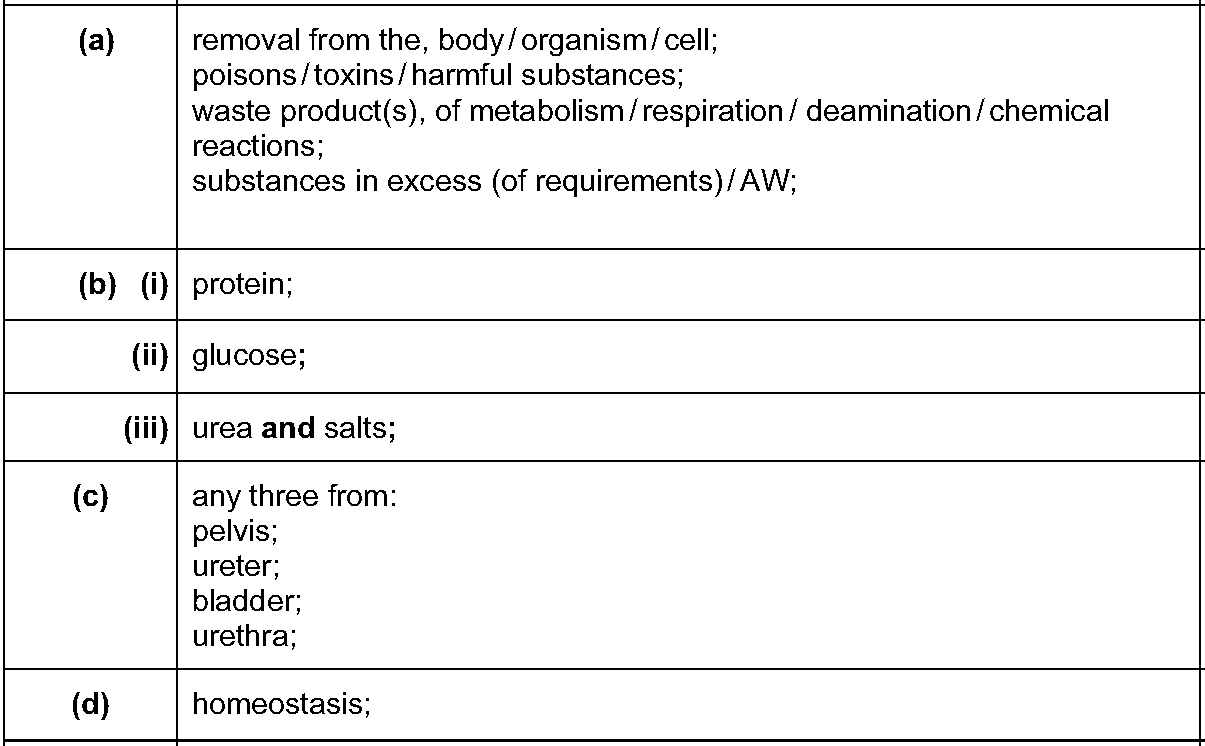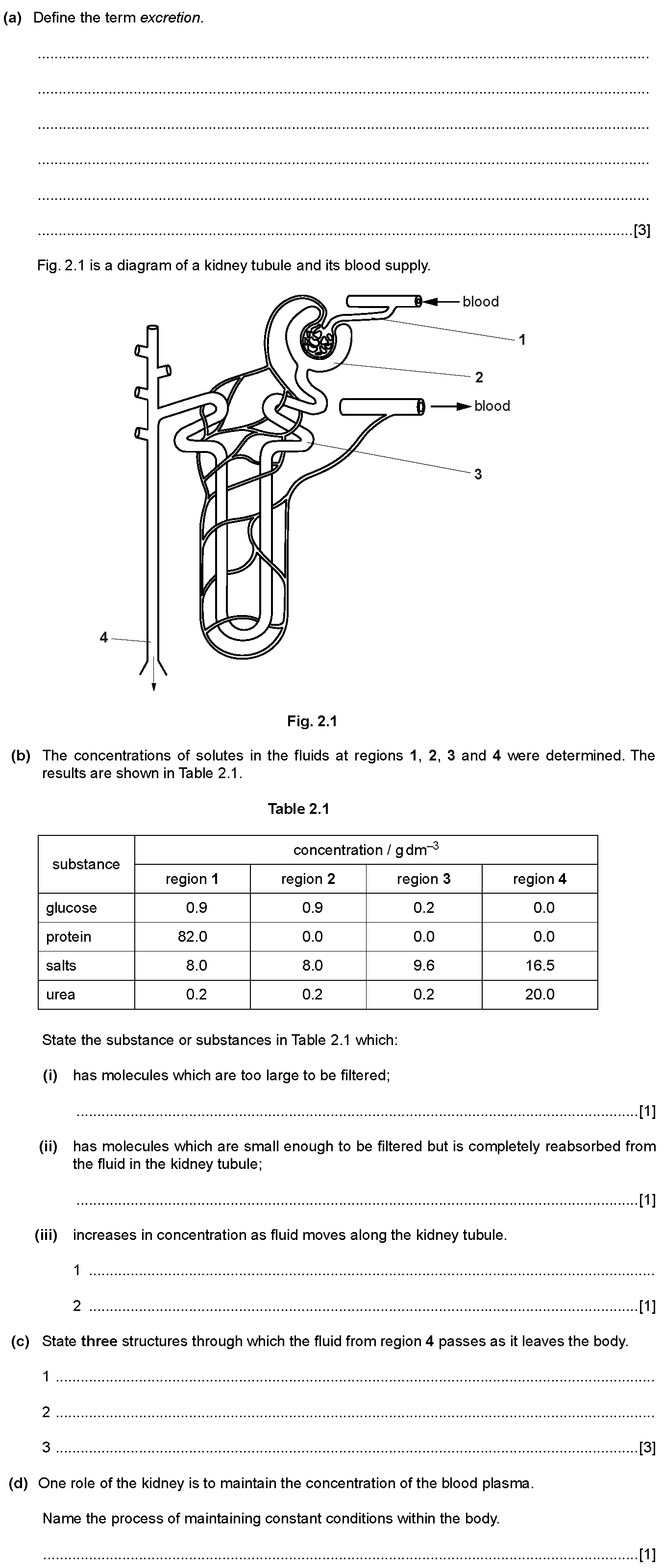
Q2:
Cambridge IGCSE Biology - 0610 - Supplement Paper 4 2014 Winter Zone 2
Questions:
2/6

Topic: CH13 - EXCRETION IN HUMANS
Solution



PRACTISE
Similar Questions

LEARN
Concepts with Sparky

More Questions from this Topic
Theory
CH13 - EXCRETION IN HUMANS
A healthy kidney controls the excretion of urea and other waste products of metabolism from the blood.
After kidney failure there are two possible tr...
2011
 Summer
Summer
 Summer
Summer
 2
2
Theory
CH13 - EXCRETION IN HUMANS
What shows the sequence of organs through which urea passes as it travels from where it is produced to where it is removed from the blood?
A kidneys ...
2012
 Winter
Winter
 Winter
Winter
 4
4
Theory
CH13 - EXCRETION IN HUMANS
Which substance is lost from the body by the kidneys, lungs and skin?
A. carbon dioxide
B. excess ions
C. urea
D. water
2010
 Winter
Winter
 Winter
Winter
 3
3
Theory
CH13 - EXCRETION IN HUMANS
Which process removes the waste products of metabolism from the body?
A. excretion
B. nutrition
C. reproduction
D. respira...
2009
 Summer
Summer
 Summer
Summer
 2
2
Theory
CH13 - EXCRETION IN HUMANS
A healthy person eats a very high-protein diet. What effect will this have on their urine?
A It will contain amino acids.
B It will contain glucose....
2012
 Winter
Winter
 Winter
Winter
 3
3
Theory
CH13 - EXCRETION IN HUMANS
The diagram shows a kidney and its blood vessels.
In a healthy person, which structures transport glucose?
A artery only
B artery and ureter
C a...
2009
 Summer
Summer
 Summer
Summer
 2
2
Theory
CH13 - EXCRETION IN HUMANS
The diagram shows the human urinary system.
Which substance is not found in the liquid at X in a healthy person?
A glucose
B sa...
2012
 Summer
Summer
 Summer
Summer
 5
5
Theory
CH13 - EXCRETION IN HUMANS
Which set of conditions would make the percentage of water in urine decrease the most?
2012
 Summer
Summer
 Summer
Summer
 4
4
Theory
CH13 - EXCRETION IN HUMANS
Which materials are excreted by kidneys and lungs?
2011
 Winter
Winter
 Winter
Winter
 2
2
Theory
CH13 - EXCRETION IN HUMANS
Blood passes through the kidney and some substances leave the blood as filtered liquid. From this liquid certain substances are reabsorbed back into t...
2009
 Winter
Winter
 Winter
Winter
 3
3
More Questions from year 2014
Theory
CH7 - HUMAN NUTRITION
Why does the energy needed by a human increase during the first ten years of life?A. Coordination and responses improve.B. Energy is needed for gamete...
2014
 Summer
Summer
 Summer
Summer
 2
2
Theory
CH1 - CHARACTERISTICS AND CLASSIFICATION OF LIVING ORGANISMS
Which feature is characteristic of both annelids and arthropods? A) compound eyes B) jointed limbs C) segmented bodies D) wings
2014
 Summer
Summer
 Summer
Summer
 2
2
Theory
CH2 - ORGANIZATION AND MAINTENANCE OF THE ORGANISM
Which features do animal cells share with plant cells? [Table_1]
2014
 Summer
Summer
 Summer
Summer
 2
2
Theory
CH1 - CHARACTERISTICS AND CLASSIFICATION OF LIVING ORGANISMS
The diagram shows an animal. Use the key to identify the animal.1 wings present ............................................ go to 2wings absent ........
2014
 Summer
Summer
 Summer
Summer
 2
2
Theory
CH2 - ORGANIZATION AND MAINTENANCE OF THE ORGANISM
Which pair of statements about a plant cell is correct?[Table_1][Table_1]:| | outer surface of the cell | position of sap vacuole ||---|----...
2014
 Summer
Summer
 Summer
Summer
 1
1
Theory
CH2 - ORGANIZATION AND MAINTENANCE OF THE ORGANISM
The diagram shows a cell. Which structure is not present?A. cell membraneB. cell wallC. cytoplasmD. nucleus
2014
 Summer
Summer
 Summer
Summer
 7
7
Theory
CH2 - ORGANIZATION AND MAINTENANCE OF THE ORGANISM
The diagram shows a section through a root.What are the levels of organisation of the labelled structures?[Table_1]
2014
 Summer
Summer
 Summer
Summer
 6
6
Theory
CH2 - ORGANIZATION AND MAINTENANCE OF THE ORGANISM
Which structures contain a cell nucleus?[Table_1]Table Key:✓ = nucleus✗ = no nucleus
2014
 Summer
Summer
 Summer
Summer
 2
2
Theory
CH3 - MOVEMENT IN AND OUT OF CELLS
The diagram shows a cell. [Image_1: Diagram of a cell] Which type of cell does the diagram show? A. an animal cell in a concentrated solution of sa...
2014
 Summer
Summer
 Summer
Summer
 2
2
Theory
CH3 - MOVEMENT IN AND OUT OF CELLS
Two identical cylinders, 40 mm long, are cut from a potato. One (W) is placed in water and the other (X) is placed in a concentrated sugar solution.Wh...
2014
 Summer
Summer
 Summer
Summer
 1
1




 Share
Share




 Previous
Previous



